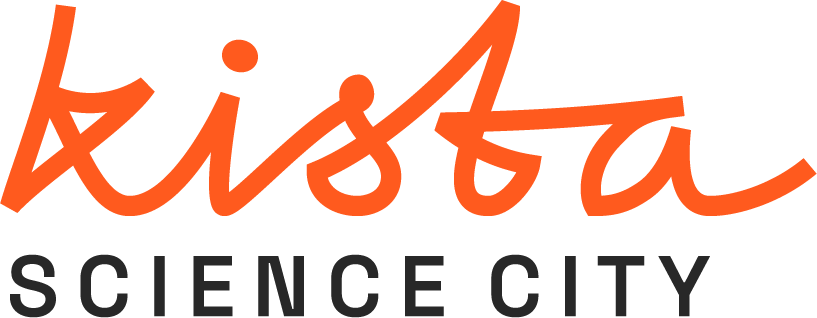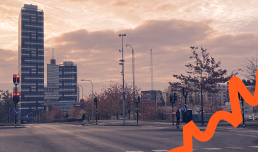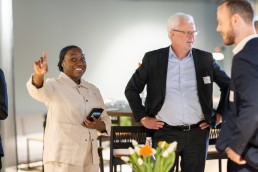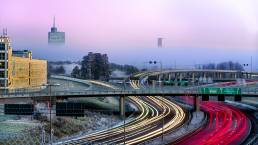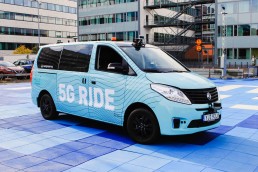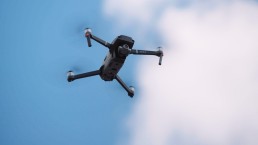Safety Lab - Aktörsdrivet trygghetslabb
Aktörer i Kista ska hitta nya sätt att jobba med upplevd trygghet
Kista Science City samlar aktörer från staden, fastighetsägare, näringslivet och lärosäten för att undersöka hur nya arbetssätt med stöd av ny teknik kan bidra till att öka tryggheten i urbana miljöer som Kista.
Upplevd trygghet är en komplex utmaning som kräver samverkan över organisationsgränser. Genom förstudien Aktörsdrivet Trygghetslabb bygger vi vidare på den goda samverkan mellan aktörer som finns i Kista. Vi ska nyttja datadrivna arbetssätt för att komma längre i arbetet med att skapa en attraktiv plats för de som studerar, arbetar och bor i Kista.
”Trygghetslabbet är en ny satsning som visar hur vi i Kista Science City tar oss an olika utmaningar kopplade till den hållbara staden. En viktig del av arbetet kommer vara att aktivera områdets community och involvera innovativa bolag med nya lösningar. Dessutom har vi redan idag en testmiljö för sensorer som kommer kunna nyttjas och en vana att sätta upp och testa nya lösningar i gaturummet på kort tid. ” Karin Bengtsson, VD, Kista Science City
Det är många faktorer som spelar in för den upplevda tryggheten, till exempel tolkning av hur stadsrummet är utformat, egna – och andras – erfarenheter av risken att utsättas för brott och upplevelse av stök. Med hjälp av IoT skulle vi kunna bli bättre på att kontinuerligt mäta och analysera trygghet och effekterna av insatser som görs, så att de verkligen träffar rätt.
”Idag finns det stora möjligheter att nyttja ny teknologi och utveckla nya arbetssätt över organisationsgränserna för att driva hållbar förändring. I piloten för trygghetslabbet ska vi ta fram förutsättningar för att göra just det.” Vanessa Ware, projektledare, Kista Science City.
Under året ska vi
– bygga ett nätverk av lokala aktörer, leverantörer och användare.
– systematiskt utforska nya arbetssätt och ny teknik där vi alltid utgår ifrån behov hos människorna i området.
– göra omvärldsbevakning på området Internet of Things och upplevd trygghet.
Projektet Aktörsdrivet trygghetslabb är delfinansierat av Vinnova.
Sensorer i nytt samarbete för intelligenta trafiksystem
Nytt samarbete kring trafikanalys via sensortekniker identifierar nya lösningar för framtidens trafikmiljö.
På en stolpe vid en fyrvägskorsning i Kista har multisensorer installerats – ett litet men viktigt steg på vägen att uppfylla stadens vision om att minska bilköer, trafikbuller och utsläpp av skadliga partiklar.
Stockholms stad, Kista Science City och flera teknikbolag utforskar tillsammans möjligheterna att mäta och analysera vägarnas trafikflöden mer intelligent, så att det blir lättare att sätta in rätt trafikåtgärder åren framöver.
Vilka fordonsslag ska få köra på vilka gator? Mellan vilka tidpunkter? Det är exempel på hur man med trafikstyrning kan påverka köer, buller och nivån av skadliga partiklar.
Utmaningen hittills har varit att man inte haft en tydlig bild av vilken trafik som kör på vilka gator. Datainsamling sker bara vid enstaka tillfällen per år, och har inte detaljerad information om vilka fordonsslag som passerar, vid vilka tidpunkter dessa passerar, eller i vilka hastigheter. Multisensor-teknik skulle kunna erbjuda allt detta – i realtid dessutom, året runt.
Ny och gammal teknik testas och jämförs
Men hur väl fungerar tekniken? Hur tillförlitlig är datan? Det är en av de saker som Stockholm stad vill ta reda på.
Testerna utförs i den relativt trafikintensiva korsningen Hanstavägen/Norgegatan i Kista . Riktigheten i datan är avgörande för att multisensorteknik ska ersätta dagens datainsamlingsmetoder. Den nya tekniken och den gamla räknar trafiken i den här korsningen, och resultaten jämförs även med ett ”människofacit”, där man räknat och klassificerat trafiken förhand.
”Här har man säkerställt att rätt personer är med”
Multisensorteknikerna som testas inkluderar bildanalys av registreringsplåtar (som vid vägtullar), radaranalys, och bild- och ai-analys av fordons former. Ändå är det inte tekniken som är avgörande:
– Utmaningen är att tekniken ska fungera i en stor skala i en komplex miljö, och tillföra stor nytta för staden. Omständigheter som GDPR, fysisk tillgång till ström och internetuppkoppling och belysning på platsen måste vägas in. Det är därför det här projektet är så värdefullt, säger David Eskilsson, vd på Edeva, ett av teknikbolagen som satt upp sensorutrustning vid korsningen.
– Här har man säkerställt att rätt personer är med, och vi abonnerar på deras tid. Vi teknikleverantörer får gå på djupet med alltifrån den it-säkerhetsansvarige på Stockholm stad till den som är ansvarig för alla trafikmätningar. Som litet teknikbolag är det vanligtvis i stort sett omöjligt att få till den här öppna dialogen med en stad. Det är guld värt.
Långsiktigt tänk med uppskalning i åtanke
David Eskilsson värdesätter också att projektet har ett långsiktigt tänk som går bortom ”proof of concept”:
– Att göra ”PoC:ar” leder ofta bara in i ett vakuum där inget sedan händer. Blicken nu är tydligt vänd mot slutvärdet och att vi ska hitta något som är tillräckligt bra och effektivt för att kunna skalas upp. Kista Science City har verkligen fått till en bra dialog mellan oss leverantörer och behovsägaren, säger David Eskilsson.
I mötet mellan Stockholms stad och teknikbolagen uppstår innovationskraft genom löpande feedbackmöten. Att samverka i en testbädd på det här sättet – med innovation och lösningar i fokus, och att successivt klargöra stadens behov och skruva på både tekniken och tänkbara lösningar i en iterativ process – är något annat än att mötas i en upphandling.
Använder Kistas infrastruktur för innovation
Lucas Uhlén, IoT-ansvarig på Kista Science City, leder projektet, som använder den infrastruktur för teknisk utveckling och innovation som redan finns i Kista:
– Vi vill erbjuda en arena där aktörer samverkar och snabbt och enkelt kan få tillgång till det urbana rummet, att testa, utveckla och visualisera lösningar med innovativ teknik för ett hållbart samhälle. Det har vi byggt upp här i Kista. Deltagarna har även tillgång till den community av andra partners, stakeholders och bolag som finns i vårt nätverk. På så sätt har de tillgång till andras perspektiv på hur lösningarna kan göras bättre eller kompletteras.
Maria Holm, ansvarig för projektet IoT Stockholm, Stockhom stad, om projektet:
”Vi är många som är angelägna om att Stockholm ska vara en attraktiv stad att bo och jobba i. Projektet är en viktig i del i vårt arbete med att få en bättre förståelse kring trafikflödena, så att vi kan se till att de fungerar optimalt framöver. Jag gläds enormt av det engagemang och den innovationsvilja som de inblandade aktörerna uppvisar. Näringslivets innovationskraft har en nyckelroll när vi skapar en hållbar framtid tillsammans.”
Projektet Multisensorer är en del av satsningsområde kring Intelligenta trafiksystem, som skapar förutsättningar för en unik insyn i dagens trafikflöden. En process och en fysisk plats där företag snabbt och effektivt får möjlighet att testa och utveckla sin teknik samt jämför lösningar med andra teknikledande bolag.
Läs mer on Intelligenta trafiksystem.
Sharing insights on trends and emerging opportunities
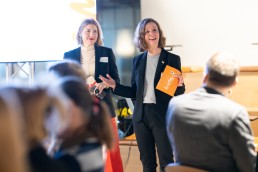
Community
Sharing insights on trends and emerging opportunities
This week leaders from the business & research community in the area met for the premiere of Kista Insight. A new meeting arena where trends and opportunities are showcased and discussed – this time with a focus on talent attraction, cybersecurity, and emerging opportunities within space.
Insight 1 - Space
Insight 1 - Space
”The number of satellites and activities in space is increasing exponentially, and this places new demands on the space industry. OHB Sweden is involved in developing a robotic “space claw” to clear space from waste by gripping debris and steering it back into Earth’s atmosphere, where it would safely burn up.“ Fredrik Sjöberg.
Fredrik Sjöberg from OHB Sweden highlighted the emerging opportunities with a growing space economy illustrated by the journey of Mats, the satellite.
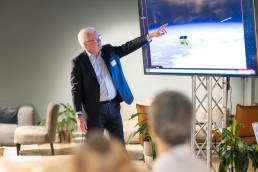

Insight 2 - Talent
Insight 2 - Talent
“Embrace the future – the majority of tomorrow’s jobs will be in tech! Let’s meet this demand head on, working together to cultivate the tech talents of today and tomorrow.” Binette Seck
Never stop learning! The world of tech is constantly evolving, but with the right steps, we can secure our place as leaders in the field. Binette Seck, founder of Changers Hub inspired to commit to lifelong learning.
True leadership means lifting those around us, especially young adults in the outermost regions. How to help them find inspiration and skills needed to thrive, to connect with role models and create the networks needed to have the faith to move forward.
Insight 3 - Cybersecurity
Insight 3 - Cybersecurity
“Cybersecurity is not only a technical matter. We need a multidisciplinary approach to meet the challenges of digitalization.” Kim Elman
Kim Elman, heading up the Cybersecurity center at RISE, talked about behavioral and economic perspectives of cybersecurity and commented on a historical absence of incitement to build secure systems.
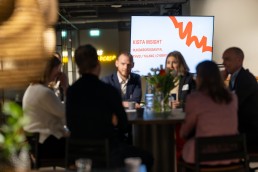
Sharing knowledge and thoughts
Kista is becoming a national powerhouse for cybersecurity, where RISE Cybersecurity center is leading the way, but also supported by the strong research at Stockholm University, FOI, and several businesses with competence in the field.
Participants reflected on the need to balance between working operationally and strategically, between what we are doing today and what the future brings. The value of open dialogue and the importance of collaboration across company borders.
Kista’s international and diverse community is an excellent opportunity to showcase that we can be at the forefront of inclusion and diversity in the tech sector.
Kista Insight is a new arena for business leaders and researchers in Kista, a place to share insights from the ecosystem and create a forum for new relationships and collaborations. If you want to join the next meeting, reach out to Mikaela Färnqvist.
Shaping the future of mobility with AI and multisensors
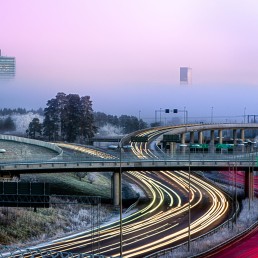
Smart City
AI and multisensors to improve urban mobility
There are today several technologies through which city traffic and pedestrian flows can be operated and manage. At the same time, and as a result of our increasing mobility behavior, cities face severe challenges with congestion, accidents and air pollution.
The utilization of sensing technology in our streets
The utilization of sensing technology in our streets comes with many possibilities, as sensing and imaging technologies are becoming advanced and collect data using various types of scanning cameras and sensors equipped with AI.
-We need to make transport smarter, more robust and more sustainable. And we also need to think about the public space, so that we make it more accessible, attractive and available for all the people. These tests are very important because we need a place where we can test new technology.” says Maria Holm, Project Manager at the City of Stockholm.
Viscando, Qamcom and Savantic are all involved in ongoing tests to promote better traffic flows based on real time data, using multisensor and AI technologies installed on the streets of Kista.
– Traditional ways of measuring traffic flows are usually based on induction lines under the road surface or on tubes laid on the streets. Our goal with the test in Kista is to evaluate whether existing technologies such as multisensors and AI-based based technologies, can provide better results and added value for the city planners, says Anna Chiara Brunetti, Project Manager at Qamcom.
– If we would be able to plan the public transportation system in a data-driven way, that would lead to much more attractive public transportation and a more sustainable city, says Claes Orsholm, Founder & CEO at Savantic.
Call for action
Are you too a Stockholm-based SME developing solutions with the potential to transform the automotive industry and transportation system? Would you like to demonstrate your solution to a wider audience, or test together with a potential business partner within the ICT or automotive sector? Please contact sara.nozkova@kista.com.
Intelligent traffic management
Multisensors is part of the focus area “Intelligent traffic management“, creating prerequisites for unique insights into current traffic flows. A process and phsysical place where businesses quick and effective can test and develop their tech and to compare solutions with other technology leaders.
Seeing through obstacles and around corners, the 5G Ride project rolls on
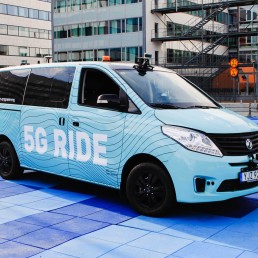
Drones
Seeing through obstacles and around corners, the 5G Ride project rolls on
The 2022 5G RIDE Demo Day on October 13 gathered more than 50 special invited guests and project partners who got a sneak preview of the latest technology updates.
This year’s demonstration focused on how new technology can be used to increase safety and security around autonomous vehicles in commuting traffic, hence offering a safer experience for travellers and other road users. The visitors got to experience how smart sensors on vehicles and in the surrounding infrastructure makes it possible for the vehicle to see through obstacles and around corners.
The sensors are an important addition to the project, as they measure positions and paths/route for all road users and sends this data in real time to Ericsson Innovation cloud, via 5G, where the data is processed, combined with other sources, and shared with the connected vehicle. The vehicle is acting upon the combined picture, from sensors, traffic tower, own cameras and the surrounding. In real time. During the demonstration we could see what happens if a person crosses the street if there is an obstacle on the path and how buildings and people are plotted on the onboard screens.
The technology enabling this is the 5G network and the traffic tower, as they fetch and share real-time data from the vehicle.
The ambition of the 5G RIDE project is to create conditions for an efficient and sustainable public transport where operators in traffic towers can support fleets of autonomous, electric vehicles to improve traffic planning, safety and reduce energy consumption. By taking a unified approach and combining technologies, the next step in the development of driverless automated vehicles is taken.
This project takes place in a collaboration between some of Sweden’s leading companies in mobility and technology. Kista Science City AB, Keolis, Ericsson, Telia, T-engineering, Viscando, Scania, Region Stockholm, intel and KTH. Working together to create a more environmentally smart and cost-efficient transport system.
For more information about the project
project manager Eleonor Sjödin Turah
eleonor.sjodinturah@kista.com
Sign up to get the latest news, updates and insights from Kista Science City
SMART
SMART
Intelligent traffic system
The project
Traffic congestion is a huge problem in urban areas. In Stockholm, car owners spend about 16 workdays stuck in traffic each year. Public transport is also affected by this, and during rush hours, bus services can suffer huge delays.
The objective of the Spatial Modelling Analytics & Real-time Tracking (SMART) Mobility Project is to mitigate growing urban traffic congestion challenges and associated issues of environmental degradation, economic inefficiency and negative impacts to the quality of life of citizens.
SMART Mobility will revolutionise the efficiency of traffic and commuting in cities by leveraging the capabilities of new 4D spatial technology and analysis platforms using real-time vehicle location and various movement data.
Several data sets
The project will use data from many different sources, including:
- Wifi data from Bumbee Labs. Position data is collected when smartphone searches for WiFi-connectivity. Bumbee Labs technologies utilizes this for crowd measurements and pedestrian flow, which is compliant with GDPR regulations.
- Vehicle data from Ramboll, Inrix and Tomtom. Through GPS, data such as speed and route can be obtained.
- Crowd data from Tre. Anonymize crowd data obtained from different sources, like cellular data and WiFi.
Project period
2020-2022
Partners
Ramboll
Bumbee Labs
Savantic
Tre
RISE
Contact
Eleonor Sjödin Turah
eleonor.sjodinturah@kista.com
Summary
SMART is a project that aims to create more effective traffic planning, with focus on public transport. The project will result in a prototype for a new platform, where many different data sets will interplay with AI technologies to predict congestion and plan routes accordingly.
The platform
The platform will be open and transparent for information and data exchange. The data sets can then be used for new types of services and applications, such as new routes for public transport and analyzing the size of a bus fleet. Through visualisation, this can be used to plan for a more effective public transport. In the end, this will benefit the end users – the travellers.
The project
The project aims to:
- Conduct three use cases in the Kista-Järva area
- Build the SMART-platform
- Integrate data sets into the platform
The anticipated result of the project is to completely integrate siloed data using 4D location. A real-time, shared and collaborative application platform will give access to multiple stakeholders. Furthermore, SMART will optimize mobility in the existing transportation network on a massive scale

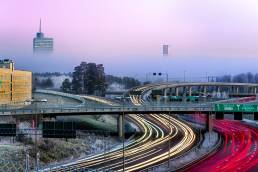
Subscribe to newsletter
Error: Contact form not found.
Drones – a natural layer in the future transport system
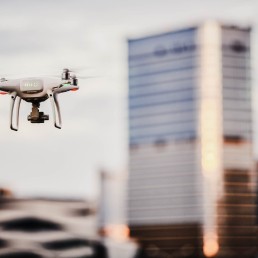
Drones
Drones – a natural layer in the future transport system
What impact will the new U-space regulations, Sustainable Urban Mobility Planning and UAMs have on Swedish authorities and entities? This topic was discussed at an event earlier this year, part of the test and demo activities in Fordonsdalen.
A broad range of stakeholders from the City of Stockholm, Region Stockholm, Luftfartsverket, Ericsson and several Stockholm based small and middle sized enterprises (SME) gathered to discuss and demonstrate the role drones will have in our future cities.
Raising awareness on how to drive a sustainable and responsible transition of urban mobility
The purpose of the meeting was to raise awareness on how to drive a sustainable and responsible transition of urban mobility into space, or the third dimension.
A vital part of the event was the discussion on how municipalities should implement the new upcoming U-space regulations, and the role of innovative SME’s in this process, showcasing safe use cases, eg data collection and inspection of first and last mile deliveries. In order to to shape the future of mobility we must have a common understanding from all parties, authorities, municipalities, researchers and startups.
Three small-sized innovative companies had the opportunity to present their solutions during the meeting;
–Skyqraft – visual data analytics provider helping businesses in the linear infrastructure sector to make better decisions about grids,
–Skysense, experts in the area of tracking aircraft, the growing field of aircraft safety and protection against drone;
–Aerit – a sustainable drone delivery service based in Stockholm.
“Unmanned aerial vehicles, or more commonly, drones, are already in use in our society for different purposes such as data collection and infrastructure inspections. The possibilities of using drones in the urban environment are endless. To establish a good balance of what use cases the citizens need and the the ones that will have the most impact in terms of environmental and social sustainability, the collaboration between the public and private sector is key.”
— Sara Nozkova, Mobility Lead at Kista Science City and project manager for the Test & Demo activities within Fordonsdalen.
Call for action
Are you too a Stockholm-based SME developing solutions with the potential to transform the automotive industry and transportation system? Would you like to demonstrate your solution to a wider audience, or test together with a potential business partner within the ICT or automotive sector? Please contact sara.nozkova@kista.com.
Sign up to get the latest news, updates and insights from Kista Science City
Nordic drone initiative
Nordic drone initiative
A platform for exchange of ideas between the Nordic countries and the rest of the world
The project
Together with other innovation clusters in the Nordics, Kista Science City founded the Nordic Drone Initiative. This project will strengthen the ties between the different clusters and help companies working with drones to learn from neighbors and form new alliances.
During the project duration, Kista Science City will represent its partners interests in dialogs with the Nordic cluster organizations, cities, and drone companies. The project creates a unique collaboration platform (first of its kind in the Nordics!) to discuss the various use areas for drones in the cities. And as the next step, act upon them through tests in real urban environment, such as Kista.
Partners
VTT, RISE, NORCE, Robots Expert, Bell Rock Advisors, Avinor, Katla Aero, Drone Nord, Gate 21, Mainbase, Flypulse, Nordic Edge, UAS Norway, LFV, Östergötland, Business Tampere
Funded by
Nordic Innovation
Summary
Together with other innovation clusters in the Nordics, Kista Science City founded the Nordic Drone Initiative. This project will strengthen the ties between the different clusters and help companies working with drones to learn from neighbors and form new alliances.
The purpose
- To identify and evaluate how drones can be used in the transport sector to provide the greatest benefit to society, business and the environment.
- Map the Nordic ecosystem for drones and the opportunities that this technology provides.
- Contribute to the development of drone technology for Nordic weather conditions.
- Propose the development of rule changes that enable drone transports and large-scale operations with vertical take-off and landing.
- Create a platform for continued research and innovation and developed international cooperation.


NDI members enjoy access to a unique network of drone experts, insights and further research/commercial project opportunities (e.g. H2020) with top Nordic drone organisations. NDI accepts new members with emphasis on commercial actors able to contribute resources in the development work.
Funded by Nordic Innovation
Nordic Innovation is an organization under the Nordic Council of Ministers and aims to make the Nordics a pioneering region for sustainable growth and works to promote entrepreneurship, innovation and competitiveness in Nordic business. Nordic Innovation supports programs and projects which contribute in fulfilling the goals of the Cooperation Program for Innovation and Business 2018-2021 which is decided by the Nordic Ministers for Business and Innovation.
Project Template
5G Ride
Autonomous vehicles
The project
5G Ride is a concept for self-driving, 5G-connected electric vehicles used in public transport. In the autumn of 2020, the vehicles were tested in traffic at Royal Djurgården. In 2021 the project continues, focusing on the development of the Connected Control Tower. Urban ICT Arena manages the project in close partnership with Ericsson, Keolis, Telia, Intel and T-Engineering.
The purpose of the project is to demonstrate safe monitoring with 5G, transfer the driver to an outside position of the vehicle and releasing resources for improved public transports. The 5G network’s unique technical features, including enhanced security, extremely high data speeds combined with low latency, means that the connected buses can respond in real time to commands from the centralized control tower.
In 2021, additional funding has been added to the project and the focus for the continuation of the project is the further development of the Connected Control Tower. One part of this is how to use more data, for example about the route, the vehicle or the connection strength, to make it possible to prevent any problems, plan routes and schedules better and act more swiftly should problems arise. New collaborations will be added with KTH the Royal Institute of Technology, the City of Stockholm and the Stockholm Region.
Project period
2020-2022
Partners
Urban ICT Arena
Keolis
Ericsson
Telia
Intel
Scania
Viscando
T-Engineering
Contact
David Eskilsson, Edeva
david.eskilsson@edeva.se
Summary
5G Ride is a concept for self-driving, 5G-connected electric vehicles used in public transport. In the autumn of 2020, the vehicles were tested in traffic at Royal Djurgården. In 2021 the project continues, focusing on the development of the Connected Control Tower. Urban ICT Arena manages the project in close partnership with Ericsson, Keolis, Telia, Intel and T-Engineering. The purpose of the project is to demonstrate safe monitoring with 5G, transfer the driver to an outside position of the vehicle and releasing resources for improved public transports.


The pilot
The pilot in 2020 was the result of a unique collaboration between some of Sweden’s most prominent and well-known organizations within the fields of mobility and technology. The knowledge hub and testbed Urban ICT Arena managed the initiative, with Keolis as bus operator. Ericsson provided the technical solution for the connected control tower, a solution that will be further developed during 2021. Telia provideded the 5G-connectivity in collaboration with Ericsson and deployed 5G at Djurgården specifically for this project. Intel delivered analytics capabilities and the technology for the processing across the network including the IT-system in the vehicles and the control tower, as well as the mobile network. T-Engineering, a Swedish technology firm, delivered vehicle and self-driving technology.
HRH Prince Daniel was among the dignitaries to attend the official inauguration ceremony outside Tekniska museet.
The project is funded by Drive Sweden, Vinnova and FFI.
Article Template

Smart City
AI and multisensors to improve urban mobility
There are today several technologies through which city traffic and pedestrian flows can be operated and manage. At the same time, and as a result of our increasing mobility behavior, cities face severe challenges with congestion, accidents and air pollution.
Last edited
2023-01-28
Duration of reading
4m
The utilization of sensing technology in our streets
The utilization of sensing technology in our streets comes with many possibilities, as sensing and imaging technologies are becoming advanced and collect data using various types of scanning cameras and sensors equipped with AI. This allows accurate information on for example traffic motion per minute, speed, and which types of vehicles are passing at certain time periods.
This is why we have decided to gather innovative ICT companies in Kista to test and evaluate their technologies in real urban environments, a project run by Sara Nozkova, Mobility Lead, Kista Science City.
-We need to make transport smarter, more robust and more sustainable. And we also need to think about the public space, so that we make it more accessible, attractive and available for all the people. These tests are very important because we need a place where we can test new technology.” says Maria Holm, Project Manager at the City of Stockholm.
Viscando, Qamcom and Savantic are all involved in ongoing tests to promote better traffic flows based on real time data, using multisensor and AI technologies installed on the streets of Kista.
– Traditional ways of measuring traffic flows are usually based on induction lines under the road surface or on tubes laid on the streets. Our goal with the test in Kista is to evaluate whether existing technologies such as multisensors and AI-based based technologies, can provide better results and added value for the city planners, says Anna Chiara Brunetti, Project Manager at Qamcom.
– If we would be able to plan the public transportation system in a data-driven way, that would lead to much more attractive public transportation and a more sustainable city, says Claes Orsholm, Founder & CEO at Savantic.
Call for action
Are you too a Stockholm-based SME developing solutions with the potential to transform the automotive industry and transportation system? Would you like to demonstrate your solution to a wider audience, or test together with a potential business partner within the ICT or automotive sector? Please contact sara.nozkova@kista.com.
Intelligent traffic systems
Multisensors is part of the focus area “Intelligent traffic systems“, creating prerequisites for unique insights into current traffic flows. A process and phsysical place where businesses quick and effective can test and develop their tech and to compare solutions with other technology leaders.
